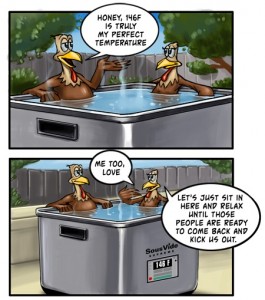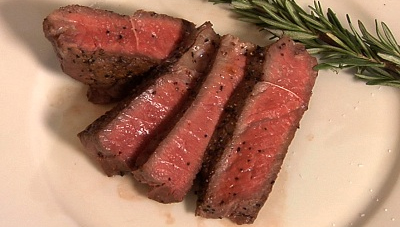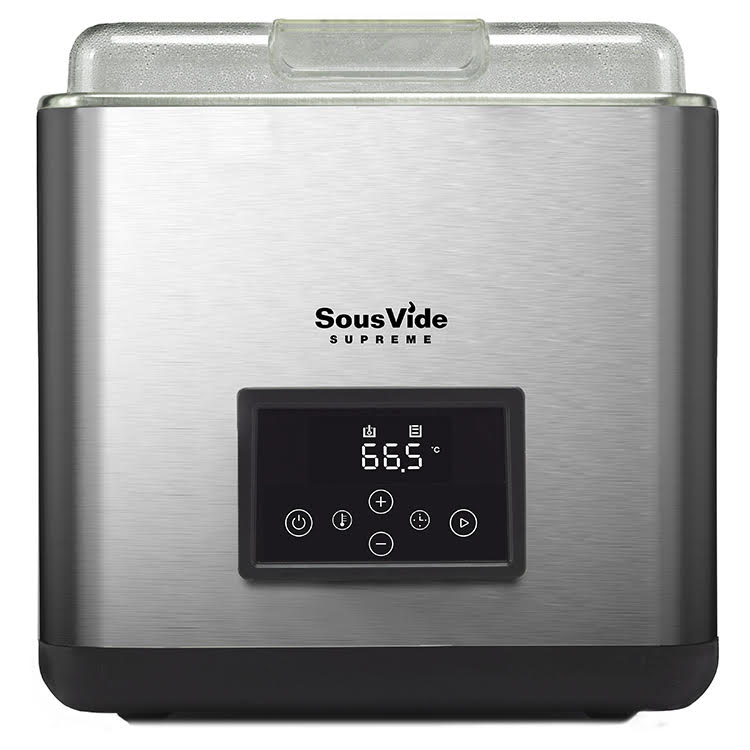You have probably heard it all before: it’s French for under vacuum. It’s pronounced soo-veed. It was pioneered in France. It’s favored by gourmet chefs the world over. You’ve seen the glamor shots of raw foods vacuum-sealed in appealing arrangements. You’ve marveled at the edge-to-edge medium rare steaks lovingly photographed on food blogs. But the question still lingers: what is sous vide cooking?
What is sous vide cooking?
Funny you should ask; we just so happen to have a video featuring co-founder Dr. Michael Eades explaining that very thing.
Dinner That Waits Up For You
One of the most convenient things about sous vide cooking is that it keeps food perfectly cooked, at serving temperature, until you’re ready to eat it. Although the popular explanation for this is witchcraft, the truth is simple: if you never heat the meat past 134ºF, it will never overcook. It can be difficult to imagine keeping food at cooking temperature without overcooking it, so let’s work with something other than food for a moment.
You can sit in a Jacuzzi (~100ºF) for hours, and as long as the temperature remains constant (and below 134ºF), you will never end up medium-rare. Pruney? Yes. Overcooked? No. The water isn’t warm enough to raise the temperature of your muscles to 134ºF/57ºC. This is just one of the reasons we do not recommend using your neighbor’s hot tub to prepare the Thanksgiving turkey.
 You can, however, use a SousVide Supreme as a hot tub for miniature cartoon turkeys.
You can, however, use a SousVide Supreme as a hot tub for miniature cartoon turkeys.
The same principle applies when you leave a steak in your SousVide Supreme for several hours (or, more specifically, the overcooking part applies; the cooking pouches keep food from becoming pruney). Once the steak has been heated to 134ºF throughout, the water will keep it at that temperature. If you never raise the temperature of the SousVide Supreme past 134ºF, you can’t raise the temperature of the steak past 134ºF. What that means for you is you can put your food in hours before you’re ready to eat it. Even better, tough cuts of meat become more tender the longer you keep them in the SousVide Supreme. The chewy flank steak you were going to feed your family becomes fork-tender after 8 hours. Sous vide cooking isn’t just good for creating gourmet meals at home; it’s also good for finding a new weeknight standby from a budget-friendly meat you might have overlooked.

Check out our Weeknight Meals in Minutes feature for easy weeknight meal planning!
“I Want To Say One Word To You. Just One Word.”
The hardest subject to broach is the issue of cooking in plastic. It might not be the best idea for us to bring it up – after all, why bring up a fear that affects our product? But, as many of us have SousVide Supremes in our own kitchens, we understand how important it is to address the subject head on.
There have recently been studies regarding the dangers of plastic (Mr. McGuire from The Graduate would be so disappointed). If you’ve heard about these studies (or read some of the more hyperbolic blog posts out there), you’ve probably wondered what this means for sous vide cooking.
We can only speak for our own products when it comes to this matter. Our cooking pouches are made from food-grade plastic that has been rigorously tested. We stress-test our pouches for four hours with boiling water (a higher temperature than is used during sous vide cooking). We use alcohol, olive oil, and distilled water in the pouches to simulate types of food that would be cooked. Even under stressed conditions, plastic components did not migrate into the “food” in the pouches. Our bags also do not contain phthalates or BPA.
Essentially: Our sous vide pouches aren’t just fancy sandwich bags (speaking of: you absolutely should not be using sandwich bags, designed for storage or the freezer, for sous vide cooking). Our pouches are designed for the rigors of sous vide cooking.
We don’t plan on resting on our laurels. If you have any questions or concerns, please contact us or leave a comment. We’d hate for you to miss out on Wild Salmon Sous Vide with Lemon Wasabi Aioli because of unanswered questions.








 Easy Returns & Exchanges
Easy Returns & Exchanges Shipping Rates & Info
Shipping Rates & Info Satisfaction Guarantee
Satisfaction Guarantee Contact Us
Contact Us Email your questions to
Email your questions to 
